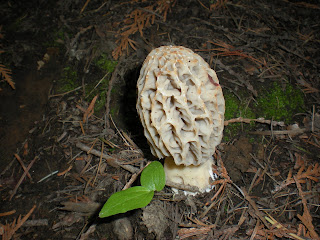
I love Gourmet's Adventures with Ruth. I very much want to be Ruth Reichl's best friend. Or possibly just be Ruth Reichl. In fact, Ruth (I call her Ruth) is the newest member of my circle of ABM (All But Met) friends, people that I know would be my great friend if only we could get past the problem of never having met. John Stewart is also an ABM friend, as is Alison Janey. If you haven't seen this show, you should, and full episodes are available on line (see link above). In the episode about Laotian cooking, she eats ant egg salad, complete with live, angry, biting, and did I mention live red ants trying to protect their eggs, and she does it with a perfect blend of horror, good humor, and respect.
As one would expect with a travel show produced by Gourmet, the emphasis is on exploring a culture and an area through food. This means local ingredients and traditional recipes. In one episode, she travels to Seattle to discover Northwest cuisine, which means, not surprisingly, seafood. I was surprised that the first seafood celebrated was, in fact, not local: it was Copper river salmon. Copper river fisheries has pulled a brilliant marketing coup on the rest of the world, convincing us that their salmon is superior to all other salmon and that we should pay top dollar for it. It is great that most Copper river salmon is native rather than farm raised, and that the Copper river itself is undamned and pristine. However, there are two things wrong with Copper river salmon. First, it's sockeye salmon, which is very lean compared to King or Chinook salmon. It is unforgiving to cook, because if you over cook it even a degree, it becomes solid and dry. Even if you don't overcook it, it is a dense, dense piece of fish. Second, the Copper river is very, very far away from here. Indeed, it is very, very far away from most fish-consuming people. That means all Copper river salmon is either frozen or "ice-packed," which is pretty close to being frozen. It also means it has to fly from there to here, which increases its carbon footprint enormously. Copper river salmon travel nearly as far as an Atlantic salmon. And all the hype about increased Omega-3 oils? All salmon is high in Omega-3 oils. Fattier salmon -- like the aforementioned Chinook, King, and Atlantic -- have more than Sockeyes. So, when you want salmon, avoid Sockeyes, and seek out actually local, native, line-caught fish. And when you find a consistent source, let me know, would you?
Back to the episode. After learning about the "glories" of Copper River, Ruth and her arbitrary guest, Tom Skerritt -- who seems as baffled about his involvement of the show as I am -- travel to the wild of Hood Canal to feast on actually local shellfish and forage. Puget Sound oysters are, in my book, the best in the world. Willapa bay oysters are small and sweet, and there is nothing one can do to one of them that will improve it other than shuck it. Shuck it, eat it. How simple is that? The foraging doesn't seem to go so well, as they spend no film time on it, and the basket of bounty they return with seems to contain two fairly small fiddlehead ferns. In short, this episode is far and away the worst one in the series so far. It is an interesting question, I think whether this was simply a bad show, or whether Northwest cuisine is actually boring.
But, I'm interested in a different question: what is Spokane local cuisine like? Clearly, what is regional and typical for us is a far, far cry from Seattle dominated "Northwest" cuisine, since we simply don't have the same connection to the sea. Do we even have a local cuisine? We live in one of the world's great grain producing regions, and yet there is not a single artisanal flour mill in the area. (For a tour of a flour mill that will make you pant with desire, see the episode on Bath. Why can't we have one of those? and then a bread bakery that takes full advantage of it? I would happily run either operation!) The Palouse grows the majority of the world's lentils, and yet I am hard pressed to find lentils that haven't been shipped elsewhere for packaging and then shipped back here for sale.
I want to issue a challenge to everyone reading this blog: let's describe a regional cuisine for the Inland Empire. It should be local and tied to the traditions and history of our region, but it should also be exciting. And tasty -- I want it to be tasty. It shouldn't be Seattle-without-seafood, and it shouldn't veer into Montana lodge cooking either, although clearly those are both related cuisines. I'm envisioning a cookery that takes advantage of the great wine coming out of the Columbia basin, the amazing fruit from Yakima and Wenatchee, the grains and legumes from the Palouse. What else? Do you have any recipes that you think fit into the description "Inland Empire Cuisine"?
